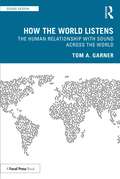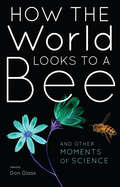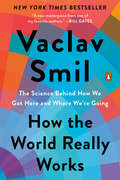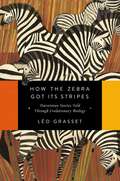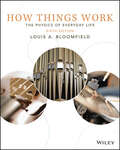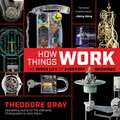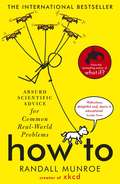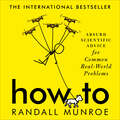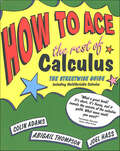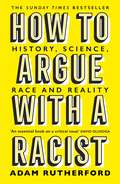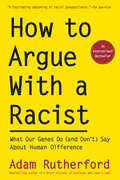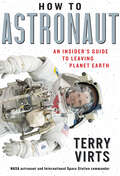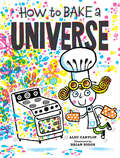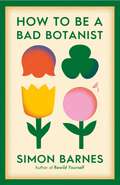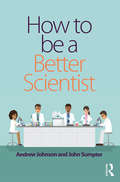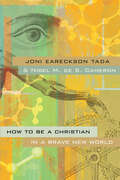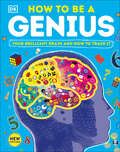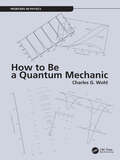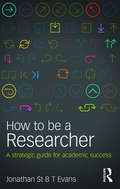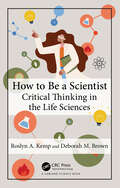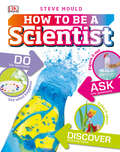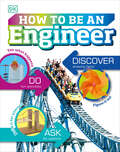- Table View
- List View
How the World Listens: The Human Relationship with Sound across the World (Sound Design)
by Tom A. GarnerHow the World Listens explores our everyday and professional interactions with sound. The book aims to uncover the human relationship with sound across the world and to reveal practical ways in which a better understanding of listening can help us in our daily lives. This book asks how sound is perceived, expressed and interacted with in both remarkably similar and dramatically different ways across the world. Using findings from a new scientific study, conducted exclusively for this book, we embark on a globe-trotting adventure across more than thirty countries, through exclusive interviews with more than fifty individuals from all walks of life, from acousticians and film composers to human resource managers and costumiers. How the World Listens is essential reading for anyone with an interest in human relationships with sound, including but not limited to sound design and music composition professionals, teachers and researchers.
How the World Looks to a Bee: And Other Moments of Science
by Don GlassGet a buzz out of science with a collection of fun facts and explanations of the world around us from the author of How Can You Tell if a Spider Is Dead?What can you learn about your world in just a moment? Have you ever wondered why the sky is blue? Or whether dogs can read our facial expressions? Don Glass and experts in their fields answer these questions and many more. Written for readers of all ages with no background in science required, How the World Looks to a Bee is the perfect armchair companion for curious people who want to know more about the science of everyday life but have only a moment to spare. With intriguing everyday phenomena as a starting point, this entertaining collectionuses short tutorials and quick and simple experiments to invite readers to test the science for themselves. These fascinating and topical science stories are sure to delight the curious child in all of us.
How the World Really Works: The Science Behind How We Got Here and Where We're Going
by Vaclav SmilINSTANT NEW YORK TIMES BESTSELLER&“A new masterpiece from one of my favorite authors… [How The World Really Works] is a compelling and highly readable book that leaves readers with the fundamental grounding needed to help solve the world&’s toughest challenges.&”—Bill Gates &“Provocative but perceptive . . . You can agree or disagree with Smil—accept or doubt his &‘just the facts&’ posture—but you probably shouldn&’t ignore him.&”—The Washington PostAn essential analysis of the modern science and technology that makes our twenty-first century lives possible—a scientist's investigation into what science really does, and does not, accomplish.We have never had so much information at our fingertips and yet most of us don&’t know how the world really works. This book explains seven of the most fundamental realities governing our survival and prosperity. From energy and food production, through our material world and its globalization, to risks, our environment and its future, How the World Really Works offers a much-needed reality check—because before we can tackle problems effectively, we must understand the facts. In this ambitious and thought-provoking book we see, for example, that globalization isn&’t inevitable—the foolishness of allowing 70 per cent of the world&’s rubber gloves to be made in just one factory became glaringly obvious in 2020—and that our societies have been steadily increasing their dependence on fossil fuels, such that any promises of decarbonization by 2050 are a fairy tale. For example, each greenhouse-grown supermarket-bought tomato has the equivalent of five tablespoons of diesel embedded in its production, and we have no way of producing steel, cement or plastics at required scales without huge carbon emissions. Ultimately, Smil answers the most profound question of our age: are we irrevocably doomed or is a brighter utopia ahead? Compelling, data-rich and revisionist, this wonderfully broad, interdisciplinary guide finds faults with both extremes. Looking at the world through this quantitative lens reveals hidden truths that change the way we see our past, present and uncertain future.
How the Zebra Got Its Stripes: Darwinian Stories Told Through Evolutionary Biology
by Barbara Mellor Léo GrassetFrance’s brightest young scientist lucidly explains the intricacies of the animal kingdom through the lens of evolutionary biology. Why do giraffes have such long necks? Why are zebras striped? And why does the clitoris of the female hyena exactly resemble and in most respects function like the male's penis? Deploying the latest scientific research and his own extensive observations in Africa, Léo Grasset offers answers to these questions and many more in a book of post-Darwinian. Complex natural phenomena are explained in simple and at times comic terms, as Grasset turns evolutionary biology to the burning questions of the animal kingdom, from why elephants prefer dictators and buffaloes democracies, to whether the lion really is king. The human is, of course, just another animal, and the author's exploration of two million years of human evolution shows how it not only informs our current habits and behavior, but also reveals that we are hybrids of several different species. Prepare to be fascinated, shocked, and delighted, as well as reliably advised—by the end, you will know to never hug the beautiful, cuddly honey badger, and what explains its almost psychotic nastiness. This is serious science at its entertaining best.
How Things Work: The Physics of Everyday Life
by Louis A. BloomfieldHow Things Work provides an accessible introduction to physics for the non-science student. Like the previous editions it employs everyday objects, with which students are familiar, in case studies to explain the most essential physics concepts of day-to-day life. Lou Bloomfield takes seemingly highly complex devices and strips away the complexity to show how at their heart are simple physics ideas. Once these concepts are understood, they can be used to understand the behavior of many devices encountered in everyday life. The sixth edition uses the power of WileyPLUS Learning Space with Orion to give students the opportunity to actively practice the physics concepts presented in this edition.
How Things Work: The Inner Life of Everyday Machines
by Theodore GrayMillion-copy bestselling author of The Elements, Molecules, and Reactions Theodore Gray applies his trademark mix of engaging stories, real-time experiments, and stunning photography to the inner workings of machines, big and small, revealing the extraordinary science, beauty, and rich history of everyday things. Theodore Gray has become a household name among fans, both young and old, of popular science and mechanics. He's an incorrigible tinkerer with a constant curiosity for how things work. Gray's readers love how he always brings the perfect combination of know-how, humor, and daring-do to every project or demonstration, be it scientific or mechanical. In How Things Work he explores the mechanical underpinnings of dozens of types of machines and mechanisms, from the cotton gin to the wristwatch to an industrial loom. Filled with stunning original photographs in Gray's inimitable style, How Things Work is a must-have exploration of stuff--large and small--for any builder, maker or lover of mechanical things.
How things work (Readers Are Leaders Ser.)
by Connie September Elizabeth EagarHome Language Grade 5 Graded Reader
How Things Work: A Child's First Library of Learning
by The Editors at the Time-Life BooksQuestions and answers provide information about how cameras, elevators, car engines, tops, yo-yos, and other devices work. Includes charts, diagrams, and an activities section.
How To: Absurd Scientific Advice for Common Real-World Problems from Randall Munroe of xkcd
by Randall MunroeRandall Munroe is . . .'Nerd royalty' Ben Goldacre'Totally brilliant' Tim Harford'Laugh-out-loud funny' Bill Gates'Wonderful' Neil GaimanAN INSTANT #1 NEW YORK TIMES BESTSELLERThe world's most entertaining and useless self-help guide, from the brilliant mind behind the wildly popular webcomic xkcd and the million-selling What If? and Thing Explainer For any task you might want to do, there's a right way, a wrong way, and a way so monumentally bad that no one would ever try it. How To is a guide to the third kind of approach. It's full of highly impractical advice for everything from landing a plane to digging a hole. 'How strange science can fix everyday problems' New Scientist'A brilliant book: clamber in for a wild ride' Nature
How To: Absurd Scientific Advice for Common Real-World Problems
by Randall MunroeThe world's most entertaining and useless self-help guide, from the brilliant mind behind the wildly popular webcomic xkcd and the #1 New York Times bestsellers What If? and Thing Explainer <P><P>For any task you might want to do, there's a right way, a wrong way, and a way so monumentally complex, excessive, and inadvisable that no one would ever try it. How To is a guide to the third kind of approach. It's full of highly impractical advice for everything from landing a plane to digging a hole. <P><P>Bestselling author and cartoonist Randall Munroe explains how to predict the weather by analyzing the pixels of your Facebook photos. He teaches you how to tell if you're a baby boomer or a 90's kid by measuring the radioactivity of your teeth. He offers tips for taking a selfie with a telescope, crossing a river by boiling it, and powering your house by destroying the fabric of space-time. And if you want to get rid of the book once you're done with it, he walks you through your options for proper disposal, including dissolving it in the ocean, converting it to a vapor, using tectonic plates to subduct it into the Earth's mantle, or launching it into the Sun. <P><P>By exploring the most complicated ways to do simple tasks, Munroe doesn't just make things difficult for himself and his readers. As he did so brilliantly in What If?, Munroe invites us to explore the most absurd reaches of the possible. Full of clever infographics and fun illustrations, How To is a delightfully mind-bending way to better understand the science and technology underlying the things we do every day. <P><P><b>A New York Times Bestseller</b>
How To: Absurd Scientific Advice for Common Real-World Problems from Randall Munroe of xkcd
by Randall MunroeThe world's most entertaining and useless self-help guide, from the brilliant mind behind the wildly popular webcomic xkcd and the million-selling What If? and Thing Explainer.For any task you might want to do, there's a right way, a wrong way, and a way so monumentally bad that no one would ever try it. How To is a guide to the third kind of approach. It's full of highly impractical advice for everything from landing a plane to digging a hole.Bestselling author and cartoonist Randall Munroe explains how to predict the weather by analyzing the pixels of your Facebook photos. He teaches you how to tell if you're a baby boomer or a millennial by measuring the radioactivity of your teeth. He offers tips for taking a selfie with a telescope, crossing a river by boiling it, and getting to your appointments on time by destroying the moon. And if you want to get rid of this book once you're done with it, he walks you through your options for proper disposal, including dissolving it in the ocean, converting it to a vapour, using tectonic plates to subduct it into the Earth's mantle, or launching it into the sun.By exploring the most complicated ways to do simple tasks, Munroe doesn't just make things difficult for himself and his readers. As he did so brilliantly in What If?, he invites us to explore the most absurd reaches of the possible. How To is a delightfully mind-bending way to better understand the science and technology underlying the things we do every day.(P)2019 Penguin Random House Audio
How to Ace the Rest of Calculus: The Streetwise Guide (How to Ace)
by Colin Adams Abigail Thompson Joel HassThe sequel to How to Ace Calculus, How to Ace the Rest of Calculus provides humorous and highly readable explanations of the key topics of second and third semester calculus-such as sequences and series, polor coordinates, and multivariable calculus-without the technical details and fine print that would be found in a formal text.
How to Argue With a Racist: History, Science, Race and Reality
by Adam RutherfordTHE SUNDAY TIMES BESTSELLER'Nobody deals with challenging subjects more interestingly and compellingly than Adam Rutherford, and this may be his best book yet. This is a seriously important work' BILL BRYSON'A fascinating and timely refutation of the casual racism on the rise around the world. The ultimate anti-racism guide for data-lovers everywhere' CAROLINE CRIADO PEREZ ***Race is real because we perceive it. Racism is real because we enact it. But the appeal to science to strengthen racist ideologies is on the rise - and increasingly part of the public discourse on politics, migration, education, sport and intelligence. Stereotypes and myths about race are expressed not just by overt racists, but also by well-intentioned people whose experience and cultural baggage steer them towards views that are not supported by the modern study of human genetics. Even some scientists are uncomfortable expressing opinions deriving from their research where it relates to race. Yet, if understood correctly, science and history can be powerful allies against racism, granting the clearest view of how people actually are, rather than how we judge them to be.HOW TO ARGUE WITH A RACIST is a vital manifesto for a twenty-first century understanding of human evolution and variation, and a timely weapon against the misuse of science to justify bigotry.
How to Argue With a Racist (and Don't) Say About Human Difference: What Our Genes Do (and Don't) Say About Human Difference
by Adam RutherfordThis authoritative debunking of racist claims that masquerade as “genetics” is a timely weapon against the misuse of science to justify bigotry—now in paperback Race is not a biological reality. Racism thrives on our not knowing this. In fact, racist pseudoscience has become so commonplace that it can be hard to spot. But its toxic effects on society are plain to see: rising nationalism, simmering hatred, lost lives, and divisive discourse. Since cutting-edge genetics are difficult to grasp—and all too easy to distort—even well-intentioned people repeat stereotypes based on “science.” But the real science tells a different story: The more researchers learn about who we are and where we come from, the clearer it becomes that our racial divides have nothing to do with observable genetic differences. The bestselling author of A Brief History of Everyone Who Ever Lived explains in this explosive, essential guide to the DNA we all share.
How to Astronaut: An Insider's Guide to Leaving Planet Earth
by Terry Virts"There's something intriguing to be learned on practically every page... [How to Astronaut] captures the details of an extraordinary job and turns even the mundane aspects of space travel into something fascinating."––Publishers Weekly Ride shotgun on a trip to space with astronaut Terry Virts. A born storyteller with a gift for the surprising turn of phrase and eye for the perfect you-are-there details, he captures all the highs, lows, humor, and wonder of an experience few will ever know firsthand. Featuring stories covering survival training, space shuttle emergencies, bad bosses, the art of putting on a spacesuit, time travel, and much more!
How to Bake a Universe
by Alec CarvlinThis whimsical and informed debut picture book takes a leaf from a cookbook to show readers how the universe came into being. To bake a universe, you’ll need a heaping pile of nothing. That’s right, not a single thing! Just make sure you have enough . . . Alec Carvlin breaks down the Big Bang into the steps of a recipe, from the formation of quarks and atoms (preheat your oven to Absolute Hot) to the compression of gases into stars and planets (just set your timer for 180 million years). Carvlin expertly balances mind-boggling facts with snappy storytelling, and Brian Biggs’s bold and contagiously cheerful illustrations bring the infinite down to the bite-sized. How to Bake a Universe is an accessible and playful authority on the formation of the universe and a heartfelt commentary on how to live in it.
How to be a Bad Botanist
by Simon BarnesCan you tell a tomato from a grape? Lawn from an oak tree? Then congratulations - you are a botanist. Self-confessed bad birdwatcher Simon Barnes thought he knew nothing about plants. He didn't object to them: trees are interesting, because birds perch in them; plants are useful as they create habitats and birds live in habitats. But while admiring the tenacity of some sea kale and yellow-horned poppy to thrive on an inhospitable shingle beach, he was struck by a truth - it all begins with plants. In this funny and inspiring book, Simon Barnes tells the story of a lifelong relationship with plants, and the realisation of the fact. Taking us from thinking ourselves ignorant about plants, to gently starting to observe seasons, patterns and places, Barnes guides us on a journey to better observing the beauty and diversity of the natural world. Both a primer on how to appreciate the plants around us and an exploration on how they make our external and interior worlds, How to be a Bad Botanist opens our eyes to the wonders around us. Plants are everywhere, in every part of your life, and you know more than you think.
How to be a Better Scientist: Researching with impact
by Andrew C. Johnson John P. SumpterUnderstanding the fundamentals of conducting good science, that will have an impact, is the goal of every aspiring scientist. Providing a wealth of tips, How to be a Better Scientist is the book to read if you want to succeed in this competitive field. Helping readers gain an insight into what good science means and how to conduct it, this book is ideal to read cover-to-cover or dip into. It includes easily accessible guidance on topics such as: • What characteristics should a scientist have? • Understanding the hypothesis • Integrity in science • Lack of confidence and the embarrassment factor • Time management • Coping with rejection • Interacting with the science community With its broad focus, this friendly guide will enthuse, inspire and challenge, and is an essential companion for all aspiring scientists.
How to Be a Christian in a Brave New World
by Joni Eareckson Tada Nigel M. de S. CameronStem-cell research. Cloning. Genetic engineering. Today, discoveries in biotechnology are occurring so rapidly that we can barely begin to address one ethical debate before another looms overhead. This brave new world we've entered is a daunting one as well, with disturbing implications for the sanctity of life and for human nature itself. How should we respond as Christians?Drawing on an abundance of cutting-edge information and life experience, Joni Eareckson Tada and Nigel M. de S. Cameron help you think through issues no Christian can afford to ignore. As a quadriplegic who has spent three decades advocating for the disability community out of a wheelchair, Joni offers the insights of a woman intimately acquainted with suffering and struggle. Dr. Cameron shares from his vast knowledge as one of today's foremost bioethics.Together, they offer deeply informed perspectives on such pressing issues as:Human cloningDesigner babiesRedefining human natureHuman harvestingHere is thoughtful, passionate, and gripping reading about the world that is coming--that, indeed, is already here--and how to live out your faith with conviction in its midst.
How to Be a Genius: Your Brilliant Brain and How to Train It (DK Train Your Brain)
by DKUse your eyes, ears, and imagination to explore your amazing mind and sharpen your wits. Do you want to calculate like Einstein, paint like Picasso, or compose like Mozart? Put your gray matter to the brain-training test and see how you measure up to some of the greatest thinkers in history. Tackle mind-boggling puzzles, games, and optical illusions and discover what makes your brain work: from why you smile to what is going on inside your head and what side of your brain does what. Learn about neurons, how memory works, and how to boost your creativity.How to Be a Genius makes a complex subject fun, accessible, and exciting, and is perfect for any child, whether they are intent on becoming a genius or just want to have fun with clever activities at home, on a journey, or in school.
How to Be a Quantum Mechanic (Frontiers In Physics Ser.)
by Charles G. WohlHow to Be a Quantum Mechanic is an introduction to quantum mechanics at the upper-division level. It begins with wave-particle duality and ends with a brief introduction to the Dirac equation. Two attitudes went into its writing: Examples are the best way to get into a subject, and numbers and equations alone do not always sum to understanding. The author taught for 40 years at the University of California, Berkeley. He earned his Ph.D. at Berkeley, in experimental elementary-particle physics in the group led by Luis Alvarez.
How to Be a Researcher: A strategic guide for academic success
by Jonathan St EvansHow to be a Researcher provides a strategic guide to the conduct of a successful research career within a university environment. Based on the author’s extensive personal experience, it offers down-to-earth advice, philosophical guidance, and discussions of the political context of academic research. This is not a research methods book, and the topics it covers are rarely discussed elsewhere. The bulk of the book provides practical advice on the development of essential skills and strategic approaches, covering questions such as: how to decide which topics to work on how to read and review literature how to develop theory how to integrate research and teaching activity how to approach research design how to obtain and manage research funding how to collaborate and supervise effectively how to write up your research, and how to secure the best sources of publication. The final part of the book considers the philosophy and psychology of research work and includes an exploration of the cognitive biases which may affect researchers. How to be a Researcher will be particularly useful for masters and doctoral students in the behavioral and social sciences, and also for early career academics developing research within a university career.
How to Be a Scientist: Critical Thinking in the Life Sciences
by Roslyn A. Kemp Deborah M. BrownMany undergraduate students choose a science degree but are not aware of how science and research work in the real world. We explain the processes of collecting, sharing and, most importantly, critical analysis of scientific research, with a focus on the life sciences. This book explains how scientific research is conceived, carried out and analysed. It outlines how research findings are constantly evolving and why that is exciting and important. Students using this textbook will learn how to design experiments, explain their data and analyse and interpret the work of others. They will learn to think about broader aspects of science, such as bias and ethics. They will gain practical skills, including understanding the use of statistical tests and how to prepare an effective presentation. Active individual and class exercises provide opportunities for students to think about difficult concepts in science and research and to include their own perspectives. Key Features: Encourages discussion and critical thinking using individual and class exercises Provides real-world examples and context for difficult concepts Allows students to assess their understanding with practical exercises and examples Documents a variety of career options and opportunities from studying science Permits students to advocate for science with suggestions for creating and sharing research Related Titles: Barrass, R. Students Must Write: A Guide to Better Writing in Coursework and Examinations, 3rd ed. (ISBN 978-0-415-35826-2)Zlatanova, J. What Is Science?: Myths and Reality (ISBN 978-0-367-46523-0)Walters, D. E. & G. C. Walters. Scientists Must Speak, 2nd ed. (ISBN 978-1-4398-2603-4)Barrass, R. Scientists Must Write: A Guide to Better Writing for Scientists, Engineers and Students, 2nd ed. (ISBN 978-0-415-26996-4)
How to be a Scientist (Careers for Kids)
by Steve MouldLearn how to think like a scientist, look at the world in a brand-new way and have tons of fun with science comedian Steve Mould's bold and playful kids science book.Supporting STEM and STEAM education initiatives, How to be a Scientist will inspire kids to ask questions, do activities, think creatively, and discover amazing fun facts! A firm favorite in classrooms and homes alike, this science book for kids has earned itself a permanent spot on many family bookshelves. With more than 40 fun questions, experiments, games, and real-life scenarios that make scientific concepts fun and relevant, it's not hard to see why! Simple activities with undetermined answers encourage curious young readers to find new ways to test ideas. The stories of the great scientists and their discoveries (and failures) are told in an entertaining way to provide even further inspiration for budding young scientists.This educational book has the amazing ability to cover a wide range of ages, so if your children have an age gap this is a fantastic way to get them to engage with each other in a fun and educational way. It is informative, colorful, well written and draws you into its pages with an insatiable appetite for the simpler facts of science. Most of the home science experiments for kids are easy to do with items most people already have around the house, making it super easy to go from idea to execution. Explore, Investigate And Test Your Ideas!Discover the skills it takes to become a scientist. Being a scientist isn't just about wearing a white coat and doing experiments in a lab. It's about exploring, investigating, testing and figuring out how things work. How To Be A Scientist is packed with fun activities and projects that let you answer lots of tricky questions and help to explain the world around you. This kid&’s educational book challenges children to think for themselves and covers topics like:- Weather, making a tornado, the water cycle, how to make a compass- Energy, hot air balloons, electricity, Newton and Einstein- The solar system, making a sundial, creating your own sunrise, phases of the moonHow to be a Scientist (Careers for Kids) is one of four fantastic books in the How to… educational books series, including How To Be A Math Genius, How to Be Good at Math, and How to Make a Better World. Official reviews include: International Literacy Association's Children's Choices 2018 Reading List"Readers will be inspired to learn more about how to think and act like these famous scientists while uncovering deep scientific knowledge they can apply through fun-filled science projects." Minnesota Parent "This mix of classic and unusual science anecdotes and experiments is just the thing for budding STEM/STEAM fans, including tips for learning how to think and act like a scientist with fun activities and simple scientific explanations of biology, anatomy, physics, astronomy, chemistry and more."
How to Be an Engineer (Careers for Kids)
by Carol VordermanClearly explained engineering concepts and fun, simple projects give kids ages 7-9 the chance to put their STEAM knowledge to the test!Teach kids to think like an engineer! The engaging projects in this book will encourage kids to investigate using items from around the house. Build a robot arm out of rulers; learn about jet propulsion with balloons; crush toilet-paper rolls to explore materials; and much more. Read about how engineers use STEAM subjects and their imaginations to think critically and solve problems. Be inspired by engineering heroes such as Leonardo da Vinci, Mae Jemison, and Elon Musk. Fun questions, engineering experiments, and real-life scenarios come together to make engineering relevant. In How to Be an Engineer, the emphasis is on inspiring kids, which means less time at a computer and more time exploring in the real world.
